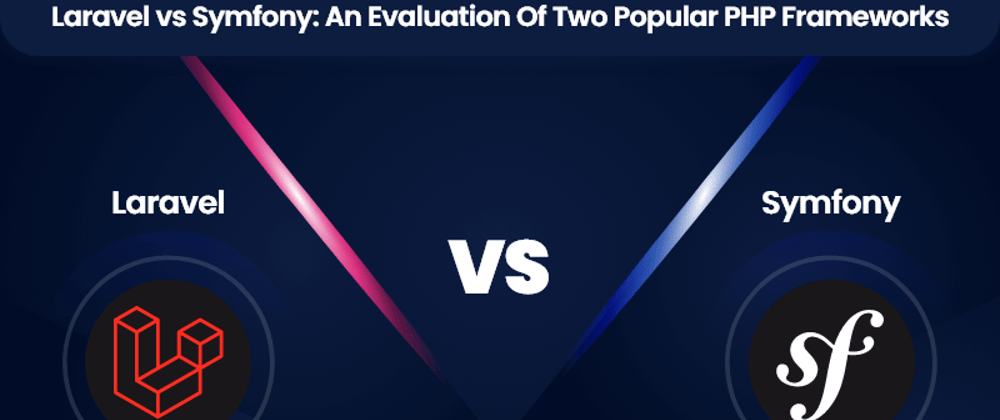Introduction
PHP frameworks are the most common choice for web development. There are numerous PHP frameworks on the market. But among web developers, Laravel and Symfony are the most widely used frameworks.
After reading this page, we trust that you won't be confused about which framework is best for you. It may be challenging to choose which will work best for your project; both offer benefits and drawbacks that you should be aware of before selecting Laravel or Symfony. Because of this, we decided to compare the two quickly.
What is Laravel?
Laravel version 4 and later are what we refer to when we discuss the framework. The framework had a thorough revamp with the release of Laravel 4 in 2013. The framework's functionality was broken down into various parts that Composer managed rather than being all contained in one colossal code repository.
Laravel describes itself as a rapid development framework with an easy-to-learn, easy-to-read, and easy-to-maintain syntax. It was the most widely used framework in 2016. It has two times as many stars on GitHub as rival frameworks, and Google Trends reports that it is three times more prevalent than competing frameworks.
What is Symfony?
The 2011 version of Symfony 2 should not be confused with Symfony 1, a very different framework built on entirely distinct tenets. Fabien Potencier developed Symfony 2, and the most recent version is 3.2, an incremental upgrade to Symfony 2. They are usually referred to as Symfony2/3 as a result.
Like Laravel 4, Symfony 2 consists of disconnected components. It has two benefits: Any Symfony component can be changed, and any Symfony component can be used in a project that doesn't use Symfony. Open source projects like Drupal, phpBB and Codeception frequently use Symfony components, making them useful as code examples.
In actuality, 14 Symfony components are used by Laravel. While working on other projects, knowing Symfony has several benefits.
Difference between Laravel vs. Symfony
• The use of MVC-based apps and numerous pre-built dependencies is prevalent. If you are using MVC apps, it is a little less versatile but more user-friendly. Increases modularity by using reused components. The code is more clearly laid out.
• The blade is the pre-installed templating engine, and unlike Twig, it supports code reuse. The framework also uses Lumen, an excellent sub-framework for building APIs. Twig is the pre-installed templating engine.
• Object-relational mapping is the foundation for Eloquent's data access (ORM). Laravel supports MySQL, PostgreSQL, SQLite, and SQLServer out of the box. Doctrine employs object-relational mapping for the data access (ORM). Symfony supports Drizzle, MySQL, Oracle, PostgreSQL, SAP Sybase SQL Anywhere, SQLite, and SQLServer.
• Field definitions are not necessary for manual database migrations because data migrations are handled automatically, and only a small number of field definitions are needed.
• Even though you must build a repository for each call, little knowledge of SQL is required. Significant SQL expertise is needed. Eloquent is less adaptable in this regard because it also ties your program to the database schema architecture.
• Laravel offers a set of standardized APIs for caching views. Symfony caches source code and views by default.
• Laravel websites often load in 60 milliseconds or less. Symfony websites typically load in about 250 milliseconds.
• The learning curve (low). Symfony Community's essential documentation The learning curve (middle). Text and video tutorials are available on GitHub, Laracast, SitePoint, Treehouse, and CodeBright.
• Approximately one million websites have been built with Laravel. Not as well known (33,000 websites built on Symfony).
• High-efficiency accelerated development, reduced coding, Advanced scalability options, easy to expand Administration and data migration are easy. Complicated web pages perform slowly. Options for scalability are easy to implement. Easy to expand maximum performance and adaptability.
• The Symfony framework has a negligibly small market share of 0.04 percent, compared to Laravel's 0.32 percent market share of all currently accessible frameworks.
• About 80,144 live websites now use the PHP Laravel framework. Currently, Symfony is utilized by 10,000,633 websites.
• Sixteen thousand nine hundred seventy-three websites in the US use Symfony components or the framework, and 3,48,499 websites in the US use Laravel.
Conclusion
Both Symfony and Laravel are frameworks with a wide range of features. Both can be utilized for different web development tasks and are both free.
Laravel is a well-liked option due to its performance and quickness. With Symfony, you can easily and quickly develop intricate, comprehensive web apps. But from my point of view, Laravel is the way to go because it is so flexible and is used by all top-tier businesses. Get the best Laravel hosting to expand and strengthen your company.







Latest comments (0)